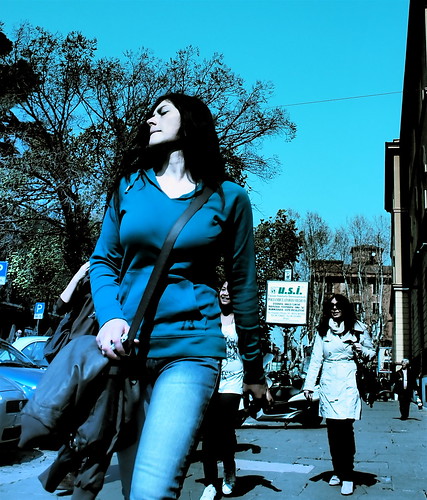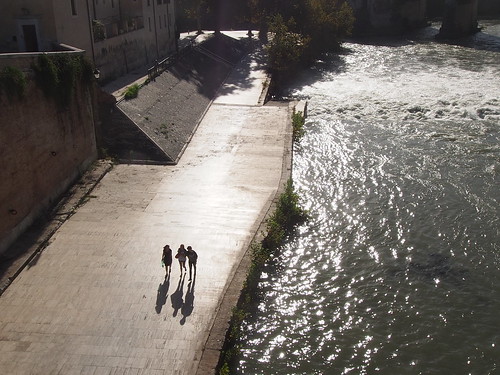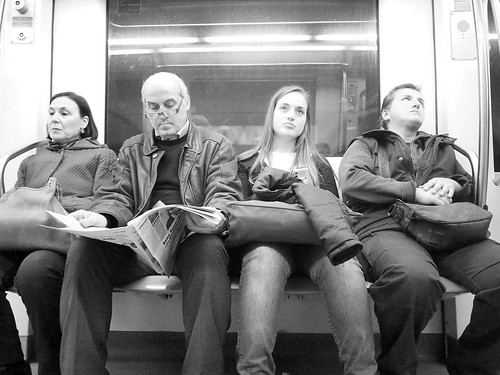As a Medieval and Ancient town Rome rests on a paradox: it is both a walled town and a garden town, among the greenest in Europe.
By the times of Augustus it had already reached one million people, being the largest of Antiquity. 200 yrs later, in 270 c.e. when Aurelianus began to encircle it with its second and last line of walls, its population was already dwindling.
When the walls were breached by the barbarians, and the empire was finished, in 450 c.e. the countryside set in and the villas of the aristocracy reclaimed the deserted spots. The first Church was built on the farm of the wife of Constantine.
By year 1000 c.e.. the population had been reduced by hunger and the plague, to 40.000 - less than the number of public statues the City had under Augustus. They all but disappeared by the time the Byzantines left town in yr. 1000.
It is only by the birth of Italy in 1861 that the city recovered. Today within its walls, still live 800.000 only a quarter of Rome's population, about the same of Augustus' times.
As a child I was lucky to live by Porta Aureliana, the most impressive post of the Northern Side, which must have fought against the Goths and the Huns. Right behind it are the noble Borghese Gardens whose gallery hosts so many classical statues and paintings.
They were none of my concerns as a kid, since I played indians and cowboys with my cousins in the vast parks of Villa Borghese.
One classical statue in the open however struck my attention, and its inscription I learned to translate as soon as I learned English:
From Childe Harold pilgrimage:
Oh Rome! my country! city of the soul!
The orphans of the heart must turn to thee,
Lone mother of dead empires! and control
In their shut breasts their petty misery.
What are our woes and sufferance? Come and see
The cypress, hear the owl, and plod your way
O'er steps of broken thrones and temples, Ye!
Whose agonies are evils of day --
A world is at our feet as fragile as our clay. (Byron)
City of the soul, indeed. And ' Lone mother of dead empires!' Those sentences were going to mark me for life, in my assessment of such a unique city, and they still haunt me:
Was it also a parallel? Could Byron have forecast the fall of the British Empire - I wondered, as he was running to help the Greek independence against the Turks?
Is it the unavoidable destiny of all empires to crumble? The British Empire took 500 yrs. to build, and only 50 to disappear utterly. Rome took much longer and transmogrified in a Spiritual Empire. There is room to ponder, sitting on a broken column like Byron did.
So in my middle age, I wondered a few years ago what equivalent I could provide visually of the broken might of my mother-city, and found no better than to dedicate one full Summer to the Walls of Rome.
Please consider that the original perimeter, 19 km long, took all the male population of Rome to build it under Aurelianus' edict in only 4 years, so great was the hurry to stop at its doors the coming Goths and Vandals from the North . It is still a huge monument, particularly by the Southern side, which includes the Cestia pyramid, and other mighty stone edifices.
Next the Pyramid, leaning against the inner side of the walls, are the two English cemeteries, to which I feel connected, because in one of them are buried both Keats and my father, the Acattolici one, and Gramsci, the frail founder of the Italian Communist Party, remebered by
Pasolini
That Summer however it was the mighty Porta S. Sebastiano and adjoining walls who took my photographic attention. With its twin towers it is also a beautiful sample of late Roman military architecture, which is sadly made ugly by street signs, so I had to learn to clone them away, one by one.
Over its terraces was an exhibition of a Chinese artist, made of stone animals - a rabbit to point to an ancient Year of the Rabbit, when Rome was still young. It was there to celebrate the link between the two oldest empires of the planet, The Chinese and the Roman ones, connected by a trade route known as the Silk Road.
Despite all the work I have only a few keepers of these huge walls. You'll need a Wide Angle and a bubble level or equivalent. If you don't have a tilt shift lens your perspectives are going to be distorted. You'll also have dynamic range problems, the exposure difference between lights and shadows being huge, especially in the Summer. So you might have to try HDR or a ND filter.
Meanwhile the cemeteries kept drawing me. In Keat's one it seemed as if I could hear again the Ode to a Nightingale:
Away! away! for I will fly to thee,
Not charioted by Bacchus and his pards,
But on the viewless wings of Poesy,
Though the dull brain perplexes and retards:
Already with thee! tender is the night,
And haply the Queen-Moon is on her throne,
Cluster’d around by all her starry Fays;
But here there is no light,
Save what from heaven is with the breezes blown
Through verdurous glooms and winding mossy ways. (Keats)
There lies the tomb 'whose name was writ in water'
Thou wast not born for death, immortal Bird!
No hungry generations tread thee down;
The voice I hear this passing night was heard
In ancient days by emperor and clown (Keats)
Not half a kilometer away it a military cemetery, the Commonwealth's one. Against one of the walls, facing the strict line of white tombs, is a moving inscription by a delegation of Englishmen, reminding that the Roman wall is of the same nature of the one which protected civilization in the Scottish north, the Adrian's Wall.
A strange short circuit of the imagination, but very true. In the Commonwealth Cemetery however are buried the crews of the bombers of Montecassino, some Jews, some Indian, people from Leeds and Birmingham, New Zealand. There might be also some American Crews, but mostly the latter are buried near Anzio.
So because of the dead, that is one of the most international corners of the old city! A City of the Dead. Byron writes:
The Niobe of nations! there she stands,
Childless and crownless, in her voiceless woe;
An empty urn within her wither'd hands,
Whose holy dust was scatter'd long ago;
The Scipios' tomb contains no ashes now;
The very sepulchres lie tenantless
Of their heroic dwellers: dost thou flow,
Old Tiber! through a marble wilderness?
Rise, with thy yellow waves, and mantle her distress. (Byron)
Those Byron's verses remind me that behind the welcoming smile of its parks and vales, the beauty of Rome is severe.
Some evidence of severity is given even today by the remnants of the House of Vestals, at the Forum. This was the oldest institution of the city.
Those girls were chosen among the noblest families of Rome to keep the Sacred Fire. If ever caught in intercourse they were immediately executed. The period of chastity lasted either 20 years, or for life, as for the Chief Vestal. To all effects, they were nuns.
They were second only to the Pontifex, the highest magistrate in Republican Rome, whose title is still carried today by the Pope. Pontifex means builder of bridges, a title that meant reconciling the savage tribes that camped on the separate river's argins, like the Etruscan and the Sannites, by building a bridge. To unite v. different tribes is still what basically the Pope does today. Religio means binding people together.
The Romans could also be pitiless with those who rebelled to Imperium. I caught recently some pictures of the inner side of the Arch of Titus, where a bas relief narrates the plunder of the Temple of Jerusalem, showing legionnaires carrying in triumph the Menorah, the seven arms sacred chandelier, which was buried under the Coliseum.
The Temple was utterly destroyed at the end of the long and bloody Jewish wars, in 70 and 135 CE, and the inhabitants carried as slaves to Rome. It was the end of Judea for 2000 years. But only 200 years later the barbarians were at the doors of Rome, at the Aurelianus' walls. And the citizens of Rome were to experiment the same cycle of plunder, rape and assassinations the Jews had gone through. It's what the Greeks called Ananke, and Dante the law of Contrappasso, the retribution of destiny.
Now just a bit of photographic advice. If you do want to do your own bit of Architecture and Landscape - and it is almost impossible not to do so in such a photogenic place, and you'd bring only one lens, make it a Wide Angle Zoom. The city Center is mostly Middle Ages narrow streets whose alleys open up suddenly on huge monuments, like the Pantheon, the Forum, the Coliseum, or St. Peter.
With a normal lens you'll never have the troom to even catch a significant part of what you shoot. Keep the normal lens for portraits of your loved ones, of for doing a bit of street shooting instead.
You can buy the
4/3 9-18 here at Amazon, or its sibling
the m4/3 one.
Rome has colored walls, most in terracotta red, which make wonderful backgrounds to passers by. Ordinary life happens in the open and people gang up easily in the summer in its convivial squares, so a theater like atmosphere develops naturally. You'll have tons of photo-opportunities, when the heat of the day relents. And tons of extraordinary dishes to try in the open air tables of trattorie. This is what you will have at the Ghetto, deep fried:




































